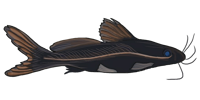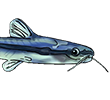
Syno ID help
- Dave Rinaldo
- Posts: 2178
- Joined: 31 Dec 2002, 10:49
- I've donated: $601.00!
- My images: 238
- My cats species list: 64 (i:0, k:0)
- Spotted: 97
- Location 2: Austin, Texas
- Dave Rinaldo
- Posts: 2178
- Joined: 31 Dec 2002, 10:49
- I've donated: $601.00!
- My images: 238
- My cats species list: 64 (i:0, k:0)
- Spotted: 97
- Location 2: Austin, Texas
I have 3 and this doesn't look the same.
Last edited by Dave Rinaldo on 14 Nov 2009, 02:36, edited 1 time in total.
- sidguppy
- Posts: 3827
- Joined: 18 Jan 2004, 12:26
- My articles: 1
- My images: 28
- My aquaria list: 5 (i:0)
- Spotted: 9
- Location 1: Southern Netherlands near Belgium
- Location 2: Noord Brabant, Netherlands
- Interests: African catfishes and oddballs, Madagascar cichlids; stoner doom and heavy rock; old school choppers and riding them, fantasy novels, travelling and diving in the tropics and all things nature.
- Contact:
- Silurus
- Posts: 12477
- Joined: 31 Dec 2002, 11:35
- I've donated: $12.00!
- My articles: 55
- My images: 903
- My catfish: 1
- My cats species list: 90 (i:1, k:0)
- Spotted: 433
- Location 1: Singapore
- Location 2: Moderator Emeritus
- Richard B
- Posts: 6952
- Joined: 11 Aug 2006, 13:19
- I've donated: $20.00!
- My articles: 9
- My images: 11
- My cats species list: 37 (i:0, k:0)
- My aquaria list: 4 (i:0)
- My BLogs: 2 (i:0, p:29)
- Spotted: 10
- Location 1: on the sofa, or maybe at work?
- Location 2: Warwickshire: UK
- Interests: Tanganyika Catfish, African catfish, Non-loricariid sucker-catfish.
Running, drinking, eating, sci-fi, stapelids
Oo-er...tricky. Definately not Brachysynodontis as mentioned previously.
I had seen something years ago, very similar labelled as S.Budgetti but who knows if this ID was correct. Ansorgii looks close but humeral looks a little different unless there is noticeble change from juv to adult?
Anyone else?
I had seen something years ago, very similar labelled as S.Budgetti but who knows if this ID was correct. Ansorgii looks close but humeral looks a little different unless there is noticeble change from juv to adult?
Anyone else?
- Dave Rinaldo
- Posts: 2178
- Joined: 31 Dec 2002, 10:49
- I've donated: $601.00!
- My images: 238
- My cats species list: 64 (i:0, k:0)
- Spotted: 97
- Location 2: Austin, Texas
Also, the spotting only occurs in the adipose fin and above the lateral line.Silurus wrote:Check the barbels to see if they are like .

Last edited by Dave Rinaldo on 14 Nov 2009, 02:29, edited 1 time in total.
I'm not sure how much help this will be, but when I worked at Armke's (where the fish came from), they came in with a group of wild caught Synos labeled "haugi Ogwe Basin Black". There were at least 3 different species in the mix. I actually have one or two of these guys left myself, and they are also around 3".
They are most likely not haugi, but if anyone knows what species are found in the Ogwe Basin (I certainly don't!), that would be a good start.
They are most likely not haugi, but if anyone knows what species are found in the Ogwe Basin (I certainly don't!), that would be a good start.
Dave Schumacher
- Erwin
- Posts: 184
- Joined: 08 Oct 2003, 14:37
- My articles: 1
- My images: 5
- Spotted: 6
- Location 1: Augsburg, Germany
- Interests: esp. cichlids, catfish
- Contact:
Thanks for the PM Dave! I haven't seen such a species alive before, and acc. to Poll, none of the fish of which a drawing is in that book fits perfectly. From its general appearance I would say its surely a West African species. Only S. budgetti has some similarities. I know, this species has an extremely formed humeral process - in adults! And acc. to Poll's drawing, no dots. Remember S. acanthomias where these features also only can be seen in adults! But the form of the snout, the hight of the body, and of the adipose would fit. Also I think I can see in the second picture that the left pectoral spine is serrated on both sides. I would give the species a cf.budgetti and wait until it grows up, to about 40 cm(!) if it is that species.
The only thing which doesn't fit is the description of small dots in the fins which Poll mentions in younger specimen: "Coloration: Brown yellowish or darker as well on the back as on the belly. The fins are partly brownish and marked with small brown spots in series + parallel, spots which disappear in the adult."
The only thing which doesn't fit is the description of small dots in the fins which Poll mentions in younger specimen: "Coloration: Brown yellowish or darker as well on the back as on the belly. The fins are partly brownish and marked with small brown spots in series + parallel, spots which disappear in the adult."
- Dave Rinaldo
- Posts: 2178
- Joined: 31 Dec 2002, 10:49
- I've donated: $601.00!
- My images: 238
- My cats species list: 64 (i:0, k:0)
- Spotted: 97
- Location 2: Austin, Texas
I've come to find out this fish had been in an LFS since (at least) 2002.
There are two more that are also 3" SL, so I would assume they won't be growing to the 30-40 cm size of .
There are two more that are also 3" SL, so I would assume they won't be growing to the 30-40 cm size of .
Last edited by Dave Rinaldo on 14 Nov 2009, 02:30, edited 1 time in total.
- Erwin
- Posts: 184
- Joined: 08 Oct 2003, 14:37
- My articles: 1
- My images: 5
- Spotted: 6
- Location 1: Augsburg, Germany
- Interests: esp. cichlids, catfish
- Contact:
All right, this is a good argument. Most (but not all) big growing Synodontis do grow continuously and especially the first year(s). Also the big eyes of your specimen don't match to good. But if you look at the only photograph in the link to the cat-eLog, you might notice, that the specimen there is not too different (besides the size of the eyes, and the basic coloration - the latter doesn't mean anything).








